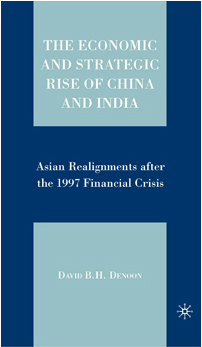Tuesday, January 8, 2008 | 12:00 AM EST - 12:00 AM EST
David Denoon, an economist and political scientist on the faculty of New York University, gave National Committee members and guests an overview of the key findings of his recently published study, The Economic and Strategic Rise of China and India: Asian Realignments After the 1997 Financial Crisis. This public program was held on the evening of January 8 in New York.
Dr. Denoon indicated that the Asian Financial Crisis began a transformation of the region’s economic and strategic alignments in ways that are still being worked out today. One of the lasting effects has been a shift in the economic balance favoring Asia’s continental nations – China and India – at the expense of the Pacific Rim countries, which were once perceived as the region’s economic tigers. Trade routes illustrate some of the trends: product designs are often done (and patented) in the United States and Japan; the fabrication of intermediate parts may be done in Taiwan, Malaysia, Korea or Thailand; and then final assembly takes place in China. Yet countries involved in the intermediate stages of production must consider when China will be ready to assume a greater role in the production process and, consequently, cut into their business.
